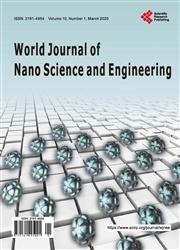Controlling Diameter, Length and Characterization of ZnO Nanorods by Simple Hydrothermal Method for Solar Cells
引用次数: 32
Abstract
Zinc oxide (ZnO) nanorods have been synthesized by solution processing hydrothermal method in low temperature using the spin coating technique. Zinc acetate dehydrate, Zinc nitrate hexahydrate and hexamethylenetetramine were used as a starting material. The ZnO seed layer was first deposited by spin coated of ethanol zinc acetate dehydrate solution on a glass substrate. ZnO nanorods were grown on the ZnO seed layer from zinc nitrate hexahydrate and hexamethylene-tetramine solution, and their diameters, lengths were controlled by precursor concentration and development time. From UV-Visible spectrometry the optical band gap energy of ZnO nanorods was calculated to be 3.3 eV. The results of X-Ray Diffraction (XRD) showed the highly oriented nature of ZnO nanorods the hardest (002) peak reflects that c-axis elongated nanorods are oriented normal to the glass substrate. The Field Emission Scanning Electron Microscope (FESEM) was employed to measure both of average diameter of ZnO nanorods, Energy Dispersive X-Ray (EDX) is used to identify the elemental present and to determine the element composition in the samples.太阳能电池用简单水热法控制ZnO纳米棒的直径、长度及表征
采用自旋包覆技术,在低温条件下采用溶液法水热法制备了氧化锌纳米棒。以脱水乙酸锌、六水硝酸锌和六亚甲基四胺为原料。首先在玻璃基板上自旋包覆乙醇醋酸锌脱水溶液制备ZnO种子层。采用六水硝酸锌和六亚甲基四胺溶液在ZnO种子层上生长ZnO纳米棒,其直径和长度受前驱体浓度和发育时间的控制。紫外可见光谱法计算出ZnO纳米棒的光学带隙能为3.3 eV。x射线衍射(XRD)结果表明ZnO纳米棒具有高度取向性,其中最硬的(002)峰反映了c轴细长纳米棒垂直于玻璃基板取向。采用场发射扫描电镜(FESEM)测量了ZnO纳米棒的平均直径,用能量色散x射线(EDX)鉴定了样品中存在的元素并确定了元素组成。
本文章由计算机程序翻译,如有差异,请以英文原文为准。
求助全文
约1分钟内获得全文
求助全文

 求助内容:
求助内容: 应助结果提醒方式:
应助结果提醒方式:


